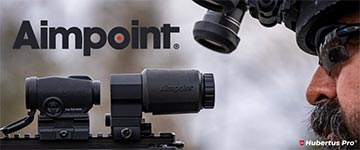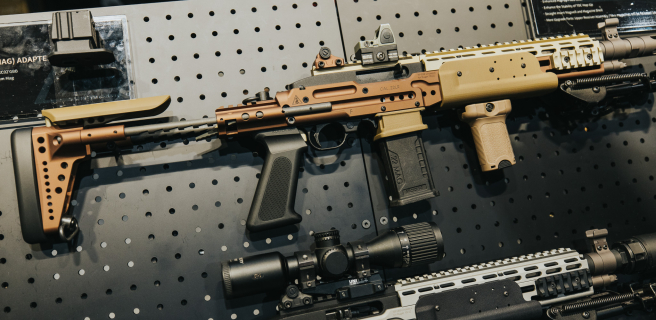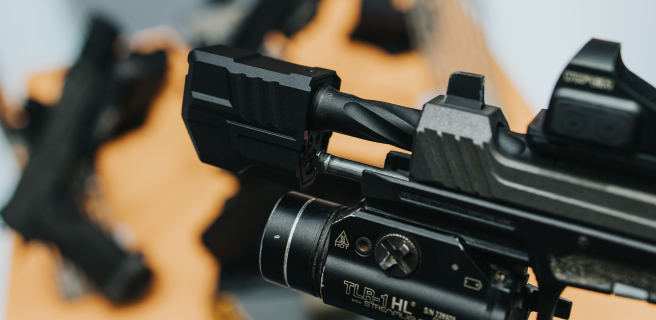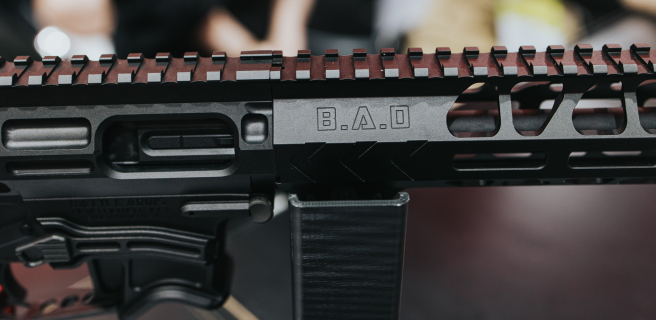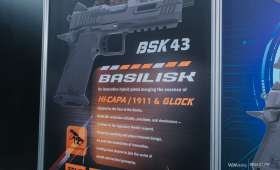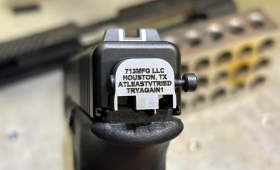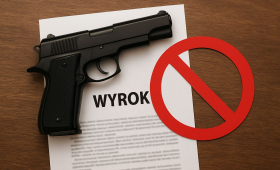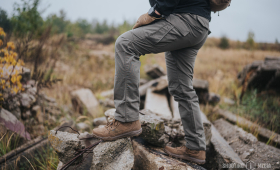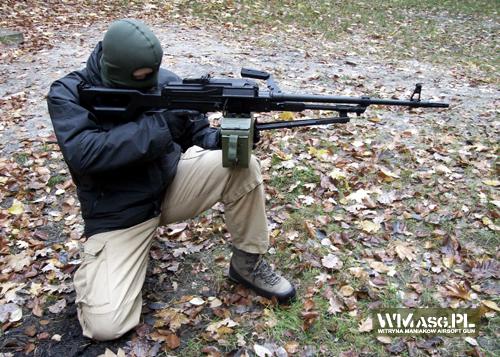
Full metal AEG replica, manufactured by Chinese company A&K, of the PKM machinegun.
Version with the stock and the pistol grip made of black synthetic fiber.
INTRODUCTION
Since the reviewed replica is new on the market, and the manufacturer nor the distributor supplied any kind of manual nor schematics of the replica – we tried to present the PKM by A&K as accurately as possible, including disassembly, in case of a stock replica out of the box.
Enjoy our review.
A BIT OF HISTORY
The PKM machinegin (Russian - Pulemiot Kalashnikova Modernizirovannyi) 7,62 x 54 mm R, is a modernized version of the PK (Pulemiot Kalashnikova), which was in service since 1961. The PKM, as a modernized version, entered mass production in 1969. The modernization was aimed ad decreasing the weight of the weapon, among other, by using more stamped parts and a different type of barrel.
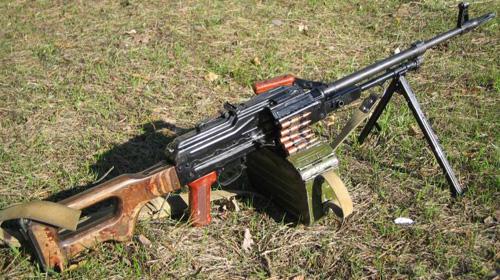
The PKM is a unit support machinegun, designed to fight targets at the distances up 1000 m (1093.61 yd). It is a gas operated, belt fed, air cooled, automatic only, machine gun. It fires from an open bolt and has a quick detachable barrel. The gas system consists of a gas chamber with a manual gas regulator, and a long stroke gas piston located below the barrel. Locking is achieved through a rotating bolt with dual locking lugs.


The PK/PKM machineguns are used by several countries. The PK/PKM was a basic machinegun of the Warsaw Pact armies. In many armies of the former soviet block, including the Polish army, it is used to this day. Also the Finish military uses this design as it equipment is mostly based on Russian weapons. Large quantities of this weapon were issued to the Finnish army in the 1990s, as a part of repayment of Russian dept towards Finland, replacing the domestic Valmet Kevyt Konekivääri machinegun. In 2010 Finland announced an tender for supplying new PKM machineguns for testing, and as the recult signed a contract with China North Industries Corporation (NORINCO), to deliver type 80 machineguns, Chinese clones of the PKM.



The PKM was manufactured not only in Russia, but also in other countries such as Bulgaria, China, Romania or Serbia, and from 1974 also in Poland in Zakładay Przemysłu Metalowego "Hipolit Cegielski" in Poznań. The PKM, as an LMG or an HMG (depending on the configuration), is still a basic support weapon in the Polish Army.

PACKAGE
The replica comes in a cardboard box with a flip cover. It has a form of a gun case with a plastic handle which makes it easier to carry around. The size of the box itself makes quite an impression since its dimensions are 1290 mm (50.78 in) / 350 mm (13.77 in) / 160 mm (6,3 in).

But is serves no informative nor marketing function since it has nor graphics, prints or stickers. Fortunately someone "took care" about a bit of information what is inside this gigantic box.

On the other hand, the issue of securing the replica was handled flawlessly. Inside the box is a foam insert – here the manufacturer deserves a big thumbs up – the weight of the replica was taken into account, therefore the top and bottom of the foam insert are sufficiently thick (about 30 mm - 1.18 in). In such conditions the replica can come to no harm through piercing the box from the inside or the outside.


Inside, together with the replica, we can find the box magazine, the battery, a simple charger and a connector used to work around the MOSFET system if someone wishes not to use it. A warranty card and a service card with the results of the preliminary inspection are also included.




The customer does not get any kind of users manual. It is a considerable drawback since this is nor a popular replica known by other users and the customer would surely benefit from information regarding its construction of disassembly.
FIRST IMPRESSION
At first glance the replica makes a very good impression – proper for its apperance and size. Also the weight, over 7000 g (15 lbs), make an impression on the user. It is worth mentioning the realism of the replica since its weight (7240 g - 15.96 lbs) is very close to the real PKM (7500 g - 16.53 lbs).


The parts of the machinegun are massive, steel plates thick, and everything seem to be indestructible.



Apart from the bipod, which has large slack when folded, the fit of the other parts of the replica is very good.

The synthetic fibers used in the replica are of good quality and do not crackle. They are stiff and appear to be solid.


EXTERNAL APPEARANCE
Basic replica parameters:
Weight: 7240 g (15.96 lbs). Length: 1185 mm (46.65 in). Inner barrel length: 508 mm (20 in).

The A&KPKM replicates the real firearm very well (of coure Polish users will not by satisfied by the lack of Polish markings). The color of the replica is black semi-matt.


The replica, apart from the handle and the stock, is made of z aluminum and steel. The steel parts are the majority. Most important parts, such as receiver, its cover and the carrying handle are made of steel. In the photos below all steel parts are highlighted by magnets.










The receiver.


The bottom shows the mounting of the box magazine, riveted to the receiver. Its circular cutaway shows the bottom of the BB feeder, which resembles a metal tube.


The button of the receiver cover. It holds the cover very well. At first glance it is similar to the one found in the AK assault rifles, but it operates differently – the cover cannot be closed with one downward movement. The button has to be pressed, since it has a lobe on the inside, which locks the cover in the receiver.


Covers’ springs – they cover the ejection ports of the spent casings and the feeding belt – they work well. They are made of steel sheets.

Through the casings ejection port you can see the gearbox.


The replica accepts the real feeding belt (these photos are just and example, unfortunately at this time we had only a belt with spent casings and not deactivated rounds).





The dummy charging handle – as shown, there is no spring there. Without lubrication it was difficult to move the handle. Lubrication fixed this issue. It stays in any position we live it in.



The stock, the pistol grip and the carrying handle covers are made of a black synthetic fiber, which is characteristic to newer versions of the PKM, manufactured or used in countries such as, e.g. : Bulgaria, China, Finland.




The synthetic fiber used is of good quality, only the stock has some visible leftovers.


Stock mount. All the parts of the replica are screwed together very stiffly or riveted.



The stock mount visible from the inside of the receiver. Between the gearbox, and the rear wall of the receiver there is an empty space. (It may by possible for pleople interested in exchanging the stock for a wooden one to use this empty space to make the mounting even more stable).


Parts of the stock. The lubricator dummy and the shoulder support. The support opens quite hard, but not as hard as in the wooden stock of the real firearm, which we were able to compare it to.





The pistol grip is manufactured flawlessly and it is identical to the original. It is narrower then in the the ones AK AEG replicas, since there is no motor inside it.



The part to which the pistol grip is screwed to is molded together with the trigger guard and is made of aluminum.

Trigger and trigger guard.



The carrying handle appears to be very solid as it is, apart from the covers, made of steel. Therefore one does not have to worry about breaking the handle while carrying the replica around.



The iron sights, the front and the rear, are made properly and esthetic. Especially the rear sight look very well. Adjustments work properly. The markings on the rear sight are painted white. In the tested replica the rear sight was mounded and fit very well - there was no slack. The base of the sight is made of aluminum. It is screwed on with a hex wrench screw. The sight cover is welded onto the receiver cover.







The front sight is vertically adjustable. The sight’s base in mounded on the barrel with pins.



Front sight vertical adjustment key is hid in the stock, in the place where the lubricator would normally be.
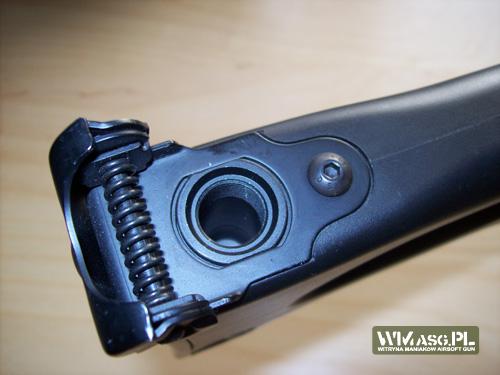

The external barrel is made of aluminum. It is massive. It is well mounted in the receiver.


Parts placed on the external barrel are pinned in place in accordance with the original.





The gas tube, seen under the barrel, is also made of aluminum. The gas tube set is mounted quite loosely in the receiver.

Part of the gas tube is used to house the MOSFET circuit together with a ROF adjustment circuit. Two buttons and markings are visible on the bottom, which in a way make the replica not true to the original in this particular spot.


Replication of the gas regulator is proper and it has 3 settings as in the real firearm.




The bipod in attached permanently to the gas tube. Care must be taken here - it is advisable to buy additional Seger rings for the pin locking the bipod in place. In the tested replica the ring broke during the first disassembly.


The bipod does not replicate the real one very well. It has slack when folded, apparently the clip holding the bipod together is to big and does not hold it stiffly enough. The legs, after clipping together, should not move against each other.

Front sling attachment.


The flash hider in screwed on a 14mm (0.55 in) counterclockwise thread. It is not true to the original as there the thread is larger.


The flash hider is characteristic to the earlier PK model. The PKM uses a different flash hider – its shorter and has a different shape. The kind of flash hider used in the replica were still used in PKM machineguns, in some countries manufacturing this weapon, especially in the initial production run of the PKM. But the PKM version with the plastic parts should have the shorter flash hider.



Safety lever.

MAGAZINE AND POWER SUPPLY
The steel box magazine supplied with the replica houses. It is an electrically operated hi-cap. The bottom of the magazine has a small switch operating the winding mechanism. There are 3 possible settings: turning the winding off, continuous winding and winding only when the trigger is pulled.



The visual appearance of the magazine is very good and is one of the more interesting parts of the replica. Its size and finish makes it a real eye candy.




Externally the magazine in almost entirely made of steel, which is shown by magnets on the photos below.




Only small parts such as the lever holding the cover in place are not steel.



The internal insert of the magazine is made of plastic. The method of feeding BBs through a stiff plastic tube is a very good solution in our opinion. There are no empty shots or jams during shooting.



After attaching the box on its mounting there is no slack. The box’s latch holds it in place very well. The mounting of the box is massive and riveted do the bottom of the receiver.

The latch of the box magazine and the end of the BB feeder. Next to the feeder is a small bolt which releases the BBs from the feeder after being pressed.


Under the cover of the box, through the feeding belt is normally pulled out, there is a hole for pouring in the BBs and also space for the battery.

This is the same spot through which the cables are inserted, both for the batter and the hi-cap mechanism. The cables are not loose and there are no problems with them being to long outside of the replica (between the receiver and the magazine), but there are also drawbacks of this design – the cables are visible, and they are clamped by the cover of the box magazine.


The cables, when not connected, can be hid under the receiver cover. Cables are connecter to the magazine through the belt feeding port.






The replica looks much better when the cables are covered by a real steel feeding belt, which can be put inside the replica with no problems – the belt is not part of the package and has to be bought separately. (this photo is just and example, unfortunately at this time we had only a belt with spent casings and not deactivated rounds).

A big drawback is this design is that the magazine cover, though which the cables are inserted, is constantly partly opened. Next to the cables there is quite a big gap, which increases in size when the feeding belt is attached. Normally this would not be a problem but the hole through the BBs are poured in is not additionally covered in any way and rapid movement of the replica, e.g. taking it up from the ground with the barrel at an upward angle or pointing the gun downwards, sometimes results in BBs falling out the magazine.



The battery space has a cover pushed down by a spring. We do not know why this cover was used in this place as it serves no real purpose. It would be much better to put it over the hole for the BBs. Alternatively the manufacturer should redesign this part of the magazine to prevent BBs from falling out.


From a magazine of this size one could expect more space for the battery. Yet, the space available is sufficient to house batteries bigger than the one supplied with the replica, a mini type NiMh 9.6 V 1200 mAh. In the era of LiPo batteries getting a suitable battery will not be a problem. The space for housing the battery has the following dimensions: 45 mm (1.77 in)/ 45 mm (1.77 in)/ 135 mm (5.31 in).


HU ADJUSTMENT
Hop-up adjustment is done by opening the receiver cover, with a ring in the hop-up chamber. Turning it left increases the HU pressure, turning it right decreases the HU pressure. The Hop-up works properly.

MARKINGS
Apart from the markings on the gas block, gas tube and under the receiver cover (which are not true to the original) – the replica has markings only over the trigger.




APPEARANCE OF THE DISASSEMBLED REPLICA

DISASSEMBLY
The replica can be disassembled in several different ways. We started from disassembling the front part. First we unscrew and pull out the screw holding the BB feeder from the bottom.


Than we open up the receiver cover. We unscrew 7 hex wrench screws on both sides of the receiver (4 on the left and 3 on the right). Than we gently pull out the front part not to damage the BB feeder tube.


We pull out the front part from the receiver and disconnect the plug connecting the electronic circuits to the rest of the replica.



If we want to disconnect the barrel we unscrew a small he wrench screw holding a pin, than we take out the blockade along with the screw. Next we pull out the pin and its spring and we take out (to the left) a wedge blocking the external barrel. Now we can pull out the external barrel (together with the HU chamber and the inner barrel).
(The whole operation is quite short. Quick disassembly of the barrel is a plus since it allows to quickly get to the HU chamber and the inner barrel to e.g. exchange the HU rubber of the inner barrel).
The barrel my by disassembled also without using any tools (a hex wrench). The pin visible on the photo (with a head in the shape if a screw) has to be pushed and moved right. Than we must turn the blockade (visible on the right end of the pin) with the lobe facing forward. It releases the wedge, which we can pull out to the left (without removing the pin) and disassemble the barrel.
Besides the fact that this should be the proper way of disassembling the barrel, we do not encourage it as the thread of the small hex wrench screw is delicate and turning the pin his way may damage the thread (it is safer to carefully unscrew the screw and take down the blockade).




The HU chamber is additionally stabilized by a metal part in a shape of a U.

After disassembling the external barrel we can easily take out the gas tube set out of the receiver, if we want to get to the electronic circuits. We push a metal plate visible on the photo and push out the gas tube.



Appearance of the electronic circuits.




To take out the gearbox we must first unscrew two Philips screws on the left side of the receiver, which releases plug connecting the cables of the to the GB. We unplug it but a forward motion.
(Below, with the GB taken out, we show the plug connected and disconnected. The two holes for the screws we took out are clearly visible).




If we want to completely take out the cables from the replica we must take out a pin holding the part visible on the photo under the ammunition feeding port. Taking out the pin reveals w hole through which the cables can be pulled out.




The gearbox is held in place by two hex wrench screws on the right side of the receiver (one is located in the reloading handle grove, the other just in front of it). Unscrewing them allows to take out the GB with an upward motion.


If need arises, one can disassemble the whole trigger group together with the safety lever. First we unscrew the pistol grip hold in place by a single screw – underneath it there are two more screws, which must me unscrewed together with the two screws visible by the trigger guard.



Now we can pull out the whole trigger group.



INTERNAL CONSTRUCTION
1. Gearbox.
The internal construction of the replica appears to be very solid. Materials used also seem, at first glance, to be of good quality. The gearbox is the some one used in Minimi (M249) replicas, which is known for is sturdiness and ability to be tuned up.
Gearbox apperance.





Before disassembling the gearbox we can release the spring by releasing the anti-reversal latch through the hole shown on the photo.

The spring can be pulled out without disassembling the GB by releasing the latch that hold the spring guide in place (visible in the top rear part of the gearbox). Pressing it releases the spring guide and the spring.


Disassembled gearbox.



Contact box.



The A&K PKM, short type motor has no markings – its magnets are weak and it is definitely unsuitable for a support weapon replica (especially if the tune up is planned).

The GB has 8 mm steel ball bearings. The are much thicker that the ones found in V.2 and V.3GBs.


Gears, with A&K markings are made of steel and are well shimmed. The motor gear had 5 anti-reversal latches.


A linear design spring is used. Its end are not grinded.

The spring guide is made of steel and aluminum and has bearings.


The piston is a standard one, with a first metal tooth. The piston head has no bearings.


Type "0" cylinder has a plastic head.


The nozzle is plastic and has no seals. Surprisingly, its seal with the cylinder head is very good – contrary to the piston head and the cylinder.


The piston-cylinder set has almost no seal at all. (It is probably w general fault in this replica as other owners we know of also pointed this fact out).
2. Inner barrel and HU chamber.
The stock inner barrel is 508 mm (20 in) ling and is well mounted in the HU chamber. To pull put the HU chamber with the inner barrel from the external barrel we unscrew the hex wrench screw holding it in place.

The hop-up chamber is made of metal.



The hop-up rubber is a standard AEG type.

The spacer is a full cylinder (and not an empty tube, as it usually occurs). It is placed vertically.

SHOOTING
The gearbox works flawlessly, and its working culture is very high. We noticed not jams nor empty shots. The magazine feed very well. Electrical winding works flawlessly.
The workings of the hop-up system is outstanding. It is very precise and does not change by itself.
Unfortunately, the lack of seal of the piston-cylinder set was a reason for the replica’s considerably small muzzle velocity.
TESTS
1. FPS and energy measurements..
The FPS and energy tests were done using Xtreme Precision 0.2g BBs.
The average muzzle velocity generated by A&KPKM on 0,2 g BBs is 343 fps, with 1.07 J of energy.
(The lack of seal of the piston-cylinder set was a reason for the replica’s considerably small muzzle velocity. Exchanging the piston head together with the piston improved the results).
Below is a table presenting 10 consecutive shots:
| Lp. | fps | m/s |
| 1 | 347 | 105.8 |
| 2 | 344.9 | 105.1 |
| 3 | 343.6 | 104.7 |
| 4 | 347.7 | 106 |
| 5 | 333.7 | 101.7 |
| 6 | 342.9 | 104.5 |
| 7 | 341.6 | 104.1 |
| 8 | 339.6 | 103.5 |
| 9 | 347 | 105.8 |
| 10 | 342.9 | 104.9 |
For comparison we present results of the muzzle velocity of the PKM replica with a proper seal of piston-cylinder set (after exchanging the piston head together with the piston).
The average muzzle velocity generated by A&KPKM on 0,2 g BBs was 423 fps.
Below is a table presenting 10 consecutive shots:
| Lp. | fps | m/s |
| 1 | 431 | 131.4 |
| 2 | 420.6 | 128.2 |
| 3 | 420.6 | 128.2 |
| 4 | 423.6 | 129.1 |
| 5 | 423.6 | 129.1 |
| 6 | 432 | 131.7 |
| 7 | 422.6 | 128.8 |
| 8 | 416.6 | 127 |
| 9 | 421.6 | 128.5 |
| 10 | 419.6 | 127.9 |
2. ROF measurement.
The measurement was done using two different types is batteries:
- 7.4 V 1280 mAh 20 C
- 11.1 V 850 mAh 28 C
Since the replica has ROF regulator built into it, both measurement were done for the maximal and minimal settings.
On the 7.4 V battery the ROF was8.5 BB per second (6.5 BBon slow).
On the 11.1 V battery the ROF was14 BB per second (7 BB on slow).
3. Accuracy and grouping on distance of 40 m (43.74 yd).
The test was carried out using aA4 target with a background of a 1:1 silhouette. The distance was measured using a 100m long measuring tape. The shots were fired using 0,25 g ICS BBs.
At the distance of 40 m we fired a series of 50 BB. All shots hit the silhouette. 14/50 hit the A4 target.

4. Maximum efficient and maximum total range.
The maximum effective range of the PKM replica is about 50 m (54.68 yd). At this distance hitting the target and the silhouette was not a problem.
The maximum range of the replica is about 55 m (60.14 yd).
SUMMARY
The replica of the PKM machinegun by Chinese company A&K offers it buyer a fairly good quality of finish and quite good replication of the original.
Contrary to many other replicas of support weapons with a box magazine the BB feeding system is designed very well, the magazine feeds and works flawlessly. Also the HU system should be praised for its precise workings. The culture of the GB workings also leaves nothing to be desired.
Unfortunately without exchanging the piston head and ideally also the piston, the replica cannot be used properly. (Besides that fat that the replica shoots really well, the lack of seal if the piston-cylinder set resulted in a considerable drop of fps).
In out opinion the A&KPKM is an interesting proposition for Soviet block weapons enthusiasts. It will be a good solution for reenactors of the Polish Army and other armies of the eastern Europe.
The editors of WMasg would like to thank SHOGUN_YAMATO for lending us his replica for the review and his help in making it.
We would also like to thank Luis for exceptional help in creating this review.
Sources:
Translated by SHOGUN_YAMATO


